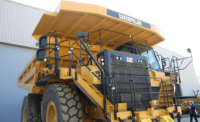
Construction equipment makers Caterpillar and Terex reported mixed earnings results in the second quarter, with slow global construction sales expected to continue through the second half of 2013. Caterpillar's most profitable segment was its power-systems business, but that was overshadowed by slow sales in its global mining and construction units. Cat's 2013 sales and revenue outlook is now in the range of $56 billion to $58 billion, a decline from an earlier outlook of $57 billion to $61 billion.
Terex reported a 5.1% drop in sales compared to Q2 2012. Its aerial work platforms sold well in the second quarter, but the company has been absorbing some restructuring costs recently, including completing its acquisition of Demag Cranes. Terex's expected sales for 2013 have been lowered to a range of $7.5 billion to $7.7 billion; the previous expectation was $7.9 billion to $8.3 billion.
Caterpillar Inc. reported $14.6 billion in sales in Q2 2013, which is down 16% over Q2 2012. "Half that was dealer inventory changes," said Cat controller Mike DeWalt on a Q2 earnings call with investors on July 24. "Last year, dealers bought more from Caterpillar than they sold to customers … now dealers bought less from us and sold more."
Much of the year-over-year decline in Cat's sales was due to lower demand in global mining, but construction equipment also saw a drop. Sales of Cat construction equipment in the second quarter were $4.85 billion, a 9% decrease from the second quarter of 2012. Globally, construction equipment sales for Cat were down in all regions, except North America. But that bright spot was a bit faint, as Cat notes in its 2Q earnings report. "In North America, increased deliveries to end users resulting from some increase in construction-related activities in the United States were about offset by changes in dealer inventory."
Analysts' early reports for Cat were gloomy, but the company's cost-cutting measures and its reported low dealer inventories changed their tune a bit. “Management will continue to cut costs in H2 [the second half of the year]; thus far, management has implemented rolling temporary lay-offs, included salaried management, and has reduced R&D spend slightly," wrote J.P. Morgan analyst Ann Duignan in a note to investors.
Caterpillar is looking a bit better after a rough first quarter of 2013, when it took a massive write-off on the acquisition of China-based mining-equipment maker ERA due to accounting irregularities. In its earnings release, Caterpillar cited that it did recoup some funds from that deal in a settlement, but most of that was offset by currency translation and hedging losses.
During the 2Q earnings call, Cat CEO Doug Oberhelman said the company is still committed to the Chinese market. "I am not one in the camp of a China implosion, that China will implode and drag the world into a black hole," he said. "We're working hard on market share in China … year-over-year sales are up." Oberhelman continued, "China will go on in fits and starts. I hope we don't see another double-digit boom, a 5% to 8% growth rate is fine—we've sized our business to that."
Second-quarter 2013 results for equipment maker Terex Corp. were mixed but beat Wall Street expectations. The equipment maker known for its aerial work platforms and cranes reported an adjusted second-quarter net profit of $398 million on $1.9 billion in net sales. Strong backlogs were reported in the aerial-work-platform division, and the company plans to expand its telehandler line. Net sales for Terex construction equipment were down 29% from a year ago, which the company blames on a soft global market for dirt- and scrap-handling equipment.
"The construction market did have a difference in market performance," said Terex CEO Ron DeFeo in a conference call on July 25 discussing the quarterly results. "But our backlog is stabilized, with $180 million this year." Terex also sold its German-based compact-component business, eliminating four facilities and significantly reducing staff. "We got out of all the component nonsense where there is not much value we can add," said DeFeo. "We're very conscious of what we have to do in construction to get this [market segment] to a more profitable position."
Joel Tiss, machinery sector analyst with BMO Capital Markets, took a more frank tone in a commentary to investors. He wrote, "[The second quarter] was another uneven and nerve-wracking quarter from Terex. We are happy that the AWP ... business continues to be the main driver of earnings as the cyclical recovery remains solid and at the same time we worry because there is no clear segment to take over as the driver of earnings when the AWP cycle eventually peaks."
On the earnings call, DeFeo cited his company's diverse offerings as an asset. "Terex is not a one-trick pony … [we have] opportunity in all segments, we don't have to hit on all of them to make progress," he said.



Post a comment to this article
Report Abusive Comment